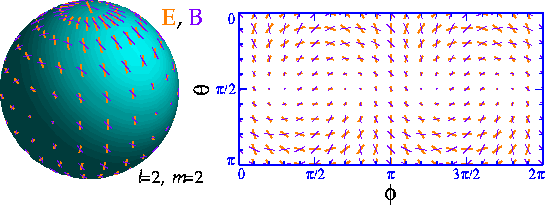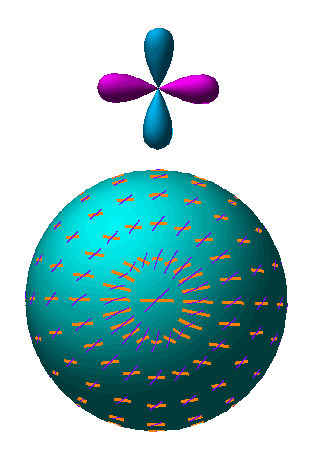Tensor fluctuations are transverse-traceless perturbations to the metric,
which can be viewed as gravitational waves. A plane gravitational wave
perturbation represents a quadrupolar ``stretching'' of space in the plane
of the perturbation (see Fig. 7).
As the wave passes or its amplitude changes, a circle of test particles in
the plane is distorted into an ellipse whose semi-major axis ![]() semi-minor axis as the spatial phase changes from crest
semi-minor axis as the spatial phase changes from crest ![]() trough (see Fig. 7, yellow ellipses).
Heuristically, the accompanying stretching of the wavelength of photons
produces a quadrupolar temperature variation with an
trough (see Fig. 7, yellow ellipses).
Heuristically, the accompanying stretching of the wavelength of photons
produces a quadrupolar temperature variation with an ![]() pattern
pattern
![]()
in the coordinates defined by ![]() .
.

Thomson scattering again produces a polarization pattern from the quadrupole
anisotropy. At the equator, the quadrupole pattern intersects the tangent
( ![]() ) plane with hot and cold lobes rotating
in and out of the
) plane with hot and cold lobes rotating
in and out of the ![]() direction with the azimuthal angle
direction with the azimuthal angle ![]() .
The polarization pattern is therefore purely Q with a
.
The polarization pattern is therefore purely Q with a ![]() dependence.
At the pole, the quadrupole lobes lie completely in the polarization plane
and produces the maximal polarization unlike the scalar and vector cases.
The full pattern,
dependence.
At the pole, the quadrupole lobes lie completely in the polarization plane
and produces the maximal polarization unlike the scalar and vector cases.
The full pattern,
![]()
is shown in Fig. 8 (real part). Note that Q and U are present in nearly equal amounts for the tensors.

